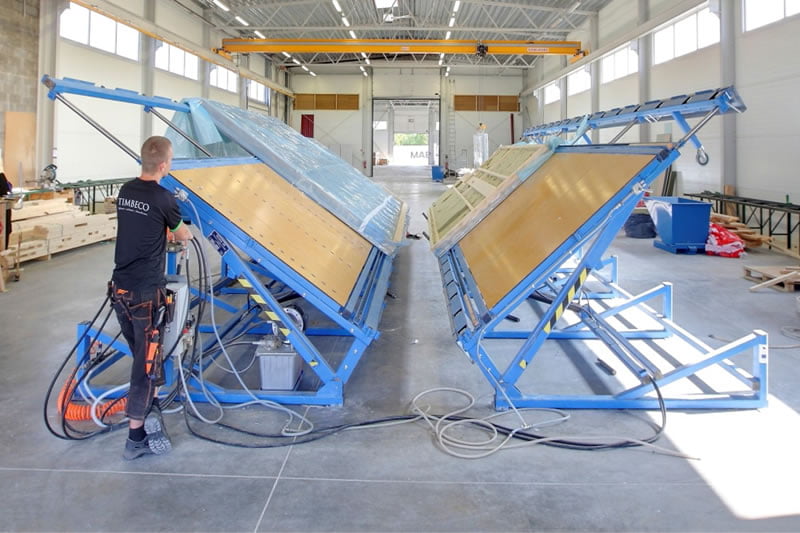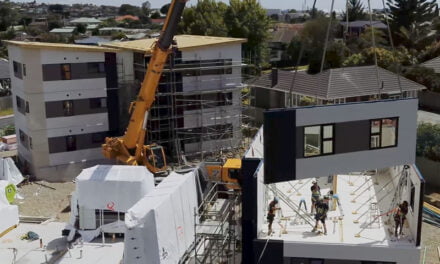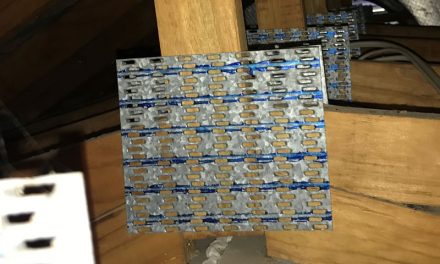A focus on world-leading automation hasn’t stopped Bliss and Reels from helping smaller fabricators make an entry into the lucrative panelisation market.
Post-war Australia was a time of booming industry. Large government infrastructure projects were being funded and materials were finally freed up from the war effort for the vast commercial and housing building catch-up that was needed, especially for the raft of European immigrants who were making the country their new home.
One such set of immigrants were Czechs who, in 1948, decided to take a gamble on importing European machinery into Australia, forming Bliss & Reels.
“They could see an opportunity. Machines they were familiar with from their own manufacturing weren’t being used here” says Jason Reints, sales manager at the company today.
“They decided to focus on bringing new machine technologies to local industry in order to improve productivity and quality. Originally, the company focused on the steel sector. But over the past decades has expanded into other markets, particularly the timber sector, and formed strong relationships with key European machine manufacturers – companies which can build machinery that specifically suit our market, but take advantage of the technology developed for their home markets”
One key partner Bliss & Reels has teamed up with is Randek. The history of this Swedish machinery company also dates back to the 1940s and it has been a pioneer in systems for growing the prefabricated house sector since the early 1960s.
“As well as their standard frame and truss machinery, such as C-presses, wall frame machines, and saws, Randek has been a leader in panelisation from very early on,” says Reints. “In Scandinavia, that’s a mature market. In Australia, it’s still developing. The prime challenge is the different industry structure. In Europe the builder is often also the prefabricator, having their own factory.”
One of the challenges, Reints explains, is that local fabricators are wary of the perceived investment levels and complexity of change to move into a new market. “But this doesn’t need to be the case,” he says, “the entry level can be very affordable, with further automation coming as the production volumes expand.”
History of innovation
“Our relationship with Randek was born out of their experience,” says Reints.
“In the ’60s and ’70s the company was developing manual and semi-automatic machines that are common knowledge now. Things like butterfly tables, semi-automatic wall frame machines, and cut saws. In the ’80s, computerised machinery started to become the main focus.”
This began with CAD-connected framing machines. As these developed, Randek added systems for automatic stud picking, placement, and nailing. In 1985, Randek was the first company in the world to deliver a CAD-connected production line for making closed wall panels, using timber frame construction.
“This was the start of what we’d now call mass customisation,” says Reints.
“This type of manufacturing equipment is commonly known about now, but at the time was groundbreaking.
“In the ’90s, Randek moved into the North American market, taking labour-saving tools from Europe and adapting them for high-speed production needs.
“Initially this took the form of the AutoWall system for wall frames with sheet bracing (used instead of noggins), and later it led to the development of the AutoFloor system, a highly automated system for open floor cassettes.”
This meant that by the time Bliss & Reels began working with Randek for the Australian and New Zealand markets, it already had a wide range of products to suit multiple fabricator sizes and types of offsite building elements. It also brought an established tradition of being able to respond with individual solutions for more bespoke customer or market needs.
“Randek are famously flexible suppliers,” says Reints. “Our first Australian customer for Randek/Bliss & Reels in the prefab sector was Universal Trusses in Canberra, who installed an AutoEye Truss System.”
Originally designed in conjunction with a Norwegian truss manufacturer who had an idea to automate and were happy to collaborate with the manufacturer, the AutoEye Truss system makes use of digital vision system technology to automatically locate roof truss joints, and then picks, places and presses the appropriate nail plates in place. “It’s a fast, accurate and proven system,” Reints says.
“Universal Trusses saw an opportunity to simplify their operations and make it easier to grow,” says Reints. Other leading fabricators including Footersville in South Australia have also installed the system.
More recently Bliss & Reels has supplied Randek systems for manufacturing floor cassettes, wall frames and wall panels. All these systems have been adapted to local requirements.
“In each case, an existing system is typically a starting point,” Reints says. “The product brochures stand as examples. We then work together with the customer on how each system could be adapted to suit their needs.
“Automated production can mean different things to different customers. It might be higher quality that’s the focus, or perhaps they are looking for an easier scaling of the business to meet the cyclical nature of the building industry.
“Additionally, our customers tell us that they are now much less dependent on finding skilled workers, which can be a challenge in different parts of the country.”
Beyond trusses
While the AutoEye Truss System has done well for Bliss and Reels, the company is working hard to encourage fabricators to move into panelisation.
“This approach has the possibility of having a big impact on the local building industry,” says Reints. “The panelised building approach can achieve lock-up on site in just a few days and complete builds in one to two months.
“This is a dramatic improvement for an industry that has seen lead-times of up to 12 months. So there are big benefits for the fabricators, builders and home buyers. For the fabricator there is also an opportunity to greatly grow the value of each project.”
But, unlike Europe, there are also several challenges for the uptake of a panelised building methodology in Australia. To get the most out of the approach a high degree of early decision making is needed.
“As the degree of the build happening off-site increases, the level of integration and dialogue also needs to increase,” Reints says. “An understanding of the manufacturing and site activities should influence the product design. This is where the big gains can be unlocked.”
While architects, engineers and building designers have shown enthusiasm for panelisation, builders and fabricators have been slower to move into the space.
“Builders can be resistant to change,” Reints admits. “The existing business model would mean a preference to order a panelised product in the same way they would a wall frame or roof truss.
“But with the local supply chain still at an early stage this has had an impact on the uptake, and also the types of prefabricators who are offering the product. So far, it’s mostly been early adopters who can see the opportunity to grow their business.”
Fabricators often cite machinery cost and plant space as reasons for their hesitation.
“The fact is that the cost to move into this space can be relatively low – a fraction what is spent on linear saws,” says Reints. “The starting point is definitely Randek’s BS20 Butterfly Tables. This is an affordable investment that allows quality closed wall panels to be manufactured.”
While there are some big truss firms moving into large-scale panelisation, such as TimberTruss, Bliss & Reels are supporting smaller fabricators that have successfully used these butterfly tables to expand their offering. “For example, FrameWayz in South Australia has been producing panelised walls and floor cassettes for some time now,” says Reints.
The footprint for these Randek entry-level systems, which are ample to manufacture elements such as floor cassettes and closed wall panels, is surprisingly small. “The space needed can be very compact and then, expanded as production volumes grow,” Reints says.
“Once the product design is understood and the volumes are there, it opens the door to further automation such as automated framing machines, multi-function bridges and robotics” he adds.
The Randek ZeroLabor system is a highly automated robotic system for manufacturing closed wall panels. Other automated systems include the AutoFloor system, which produces floor cassettes and the AutoWall system for wall frames. Both have greatly reduced staffing requirements to achieve higher production output.
“We understand that further work is being done on the standards to embrace offsite construction,” says Reints. “Having a building inspector physically inspect every panel is not the way forward in our view. A production quality system with the fabricator having systems to ensure they build what is designed, and what is designed is checked to be compliant with code is the model we can see being the most successful.”
Bliss & Reels also supply Essetre CNC cutting machines. This 40-year-old company has a wide range of models designed for use by frame and truss fabricators, as well as for processing mass timber elements such as CLT panels and glulam beams. “The mass timber products have a great deal of attention on them,” Reints says, “and have been a great way to publicise building with timber.
“We see a big future for timber construction.”
For more information, visit www.blissandreels.com.au
Image: The BS20 Butterfly Tables provide an affordable entry to panelisation for fabricators.












